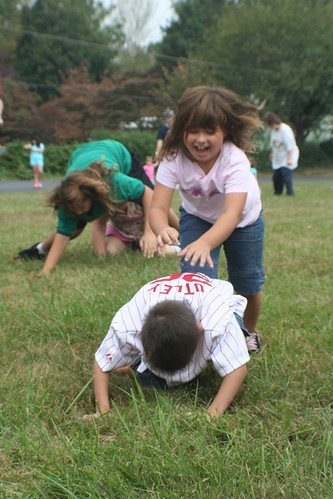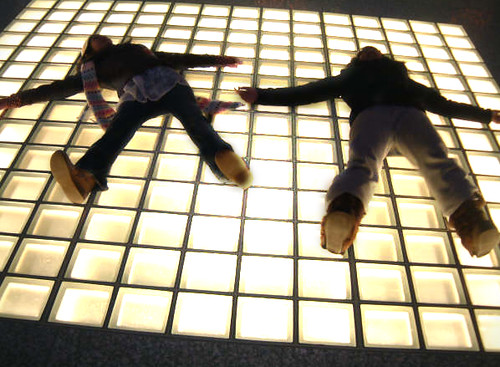
- Image by solostinwi via Flickr
About a month ago I pinched a nerve in my neck. OUCH! Even though the experience was less than ideal, I was able to tune into my body and learn or, I should say, re-learn some very important body lessons. As a firm believer in learning through our kinesthetic experiences, this strengthened my educational philosophy and excited my teacher self, even with ice packs pressed firmly on my neck.
The nerve I pinched was on the right side of my neck, which caused major pain down my right arm. As a right handed person, this affected everything from brushing my teeth to buttoning my pants. It was so interesting to observe how heavily right handed I am and how hard it was for me to switch gears and use my left arm more. it has an affect how I move my body in general as well as my balance. The quote “practice what you preach came to mind” and since I am now practicing using both sides of my body more in my life, I feel I can now preach more effectively, so hear goes!
Coordinating the Body
A balanced and integrated body is necessary for movement mastery. To explain, I am going to break down the various ways we can organize and coordinate our body. Explore these concepts with your students and see what you discover! These concepts are heavily influenced by Laban/Bartenieff Fundamentals.
Upper/Lower Body
 You can break down movement into utilizing the upper half of your body (torso, arms, shoulders, back and head) and the lower half (hips, legs, knees, and feet.) This is something we do all the time when we teach. First we teach steps with the feet and then we add the choreography for the arms.
You can break down movement into utilizing the upper half of your body (torso, arms, shoulders, back and head) and the lower half (hips, legs, knees, and feet.) This is something we do all the time when we teach. First we teach steps with the feet and then we add the choreography for the arms.
Are your students aware that they have a lower and upper half and that they are doing a great job coordinating the two? You might ask why this is important and the answer is for body awareness and ultimately better execution of technique.
Play a game where they are only allowed to use the lower half of their bodies. They can run, skip jump, bend, tap, wiggle – but only from the hips down. Then they can only use their upper halves: torso, back, ribs, shoulders, neck and head. Next, tell them to put the two together. See if it is easier for them to use both the top and bottom of their bodies with this new understanding that they achieved from their kinesthetic exploration. It is one thing to be told how your body works and it is another thing to explore it and learn for yourself.
When kids play leap frog they are illustrating this upper body/lower body concept beautifully (otherwise known as homologous movements). Reaching out with the arms, pulling the upper body forward and then jumping with their legs is a perfect homologous movement or in kid terms a frog jump. See if you can think of other ways we might move in an upper/lower way.
When I teach mommy and me classes I teach these concepts and share with the parents what we are doing and why. I feel this helps the parents become knowledgeable about the importance of the activities and helps them to reinforce the movements at home. (It also helps them in their own body awareness.)
Right Side/Left Side
 It is fun to play with the right and left sides of the body. We can move in a homolateral way, meaning right side (right arm, right leg) or in a contralateral way, meaning left arm, right leg. Naturally when we crawl or walk we move contralaterally. You might notice that when you teach a step like a leap kids and adults will over think the step and leap stretching out the same arm and leg. They turn the step into a homolateral one.
It is fun to play with the right and left sides of the body. We can move in a homolateral way, meaning right side (right arm, right leg) or in a contralateral way, meaning left arm, right leg. Naturally when we crawl or walk we move contralaterally. You might notice that when you teach a step like a leap kids and adults will over think the step and leap stretching out the same arm and leg. They turn the step into a homolateral one.
I teach kids how to connect to the right side or left side (otherwise known as body half) by doing an exercise lying on the floor in an “x”position. Which literally means that you should look like an “x;” arms overhead and spread out, and legs spread out making the bottom of the “x.” I ask them to bring their right elbow to their right knee by bending both their knee and elbow so they meet. Then they should go back to the “x” position and do the other side. Kids love moving and exploring in all sorts of different ways and I always hear sounds of glee as they discover this fun new way of moving. (This exercise is taken directly from my Barteniff Studies.)
To understand how moving the right side independent of the left and vice versa helps dancers perform various skills, all you have to do is analyze a pique turn or chanines turns. When you are performing a pique turn to the right, the right leg steps up and the left side comes around. I can’t count how many times my ballet teacher used to tell me to bring my left side around. I now understand this concept on an entirely new level.
See if you can discover other ways we move homolaterally.
Contralateral movement
 Contralateral movement might be easier to analyze because this is how we move all the time. We move this way every time we walk. But some kids need extra work in this area, and it will not only help them in dance but in their everyday lives. Think about when you throw a ball. You step with your left and throw with you right. You are using the natural spiral in your body for power. If a child is does not have the contralateral connection, this will be amazingly difficult.
Contralateral movement might be easier to analyze because this is how we move all the time. We move this way every time we walk. But some kids need extra work in this area, and it will not only help them in dance but in their everyday lives. Think about when you throw a ball. You step with your left and throw with you right. You are using the natural spiral in your body for power. If a child is does not have the contralateral connection, this will be amazingly difficult.
Movement is a layered experience. We develop movement patterns and then continue to relearn them as we get older. Babies learn to crawl, developing the spiral and then relearn and master it as they walk and then run.
When I teach my mommy and me classes, I always crawl as an activity. The parents are usually puzzled at first because their kids know how to do this. I explain the more practice the better! The kids can continue to develop these contalateral movement patterns and the parents can take the time to re-learn these patterns as well. The parents all get a new appreciation of the movement because their children are so much faster then they are!!

Body Integration in Class
As you continue to teach, see if you can bring a new awareness to body integration. For teachers with little ones, can you create activities to help your students build these important connections? And for teachers with older students, see if your students can demonstrate homologous, homolateral and contralateral movements. Who knows what they will develop and learn about their bodies, all by tuning in to their bodies.
I would love to hear what you and your students discover. As for me, I am off to ice my neck with my left hand. I love re-learning through my experiences, hopefully next time it will be a little less painful!
Stacey Pepper Schwartz is the Founder and Director of Leaping Legs Creative Movement Programs. The focus of Leaping Legs is to help people regardless of age, experience or ability, become educated about their movement potential, develop kinesthetic awareness, and become more physically fit and healthy together as a family, and community. Leaping Legs promotes its goal through its original Up Down & All Around DVD, teacher training, and school and community workshops. The Up Down & All Around DVD received Dr. Toy’s 100 Best Children’s Products 2009 Award and 10 Best Active Products 2009 Award. The DVD has also been featured in many magazines including Dance Teacher and Dance Retailer News. In its August 2009 issue, Dance Teacher called the DVD “an essential tool for teaching the fundamentals of movement with daily adult-child interactions.” Come visit www.leapinglegs.com to learn more about Stacey and her programs.

![Reblog this post [with Zemanta]](https://img.zemanta.com/reblog_e.png?x-id=ce9f76a4-7607-4c9e-a0e7-0b39fa632224)
